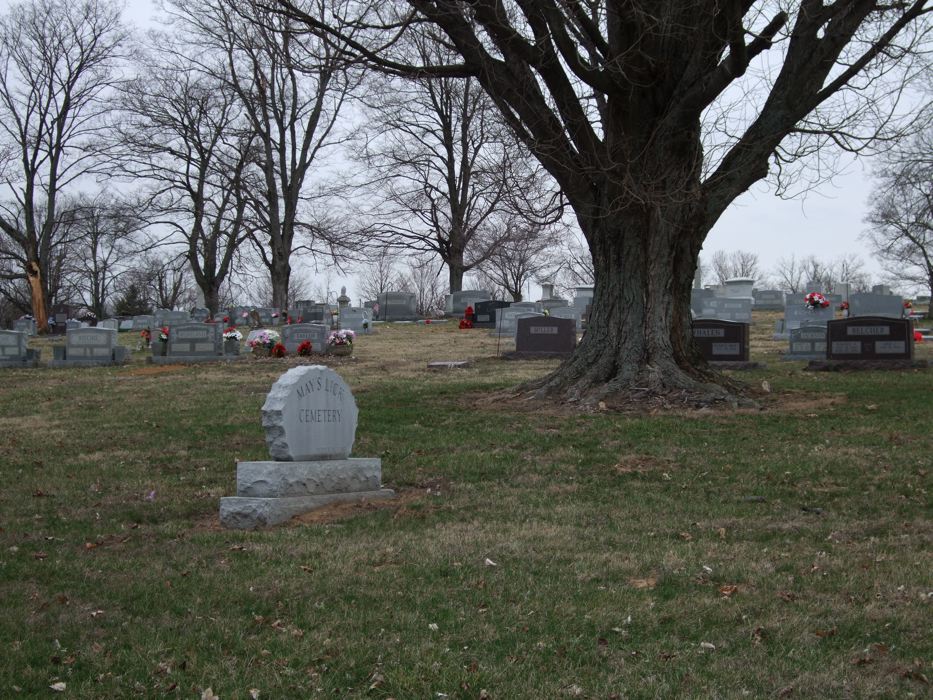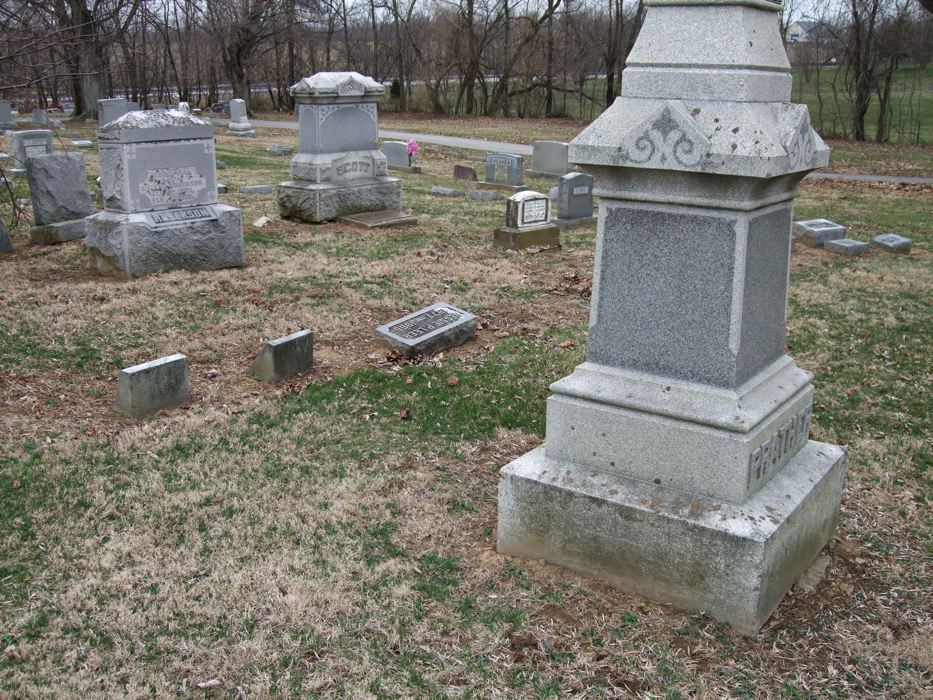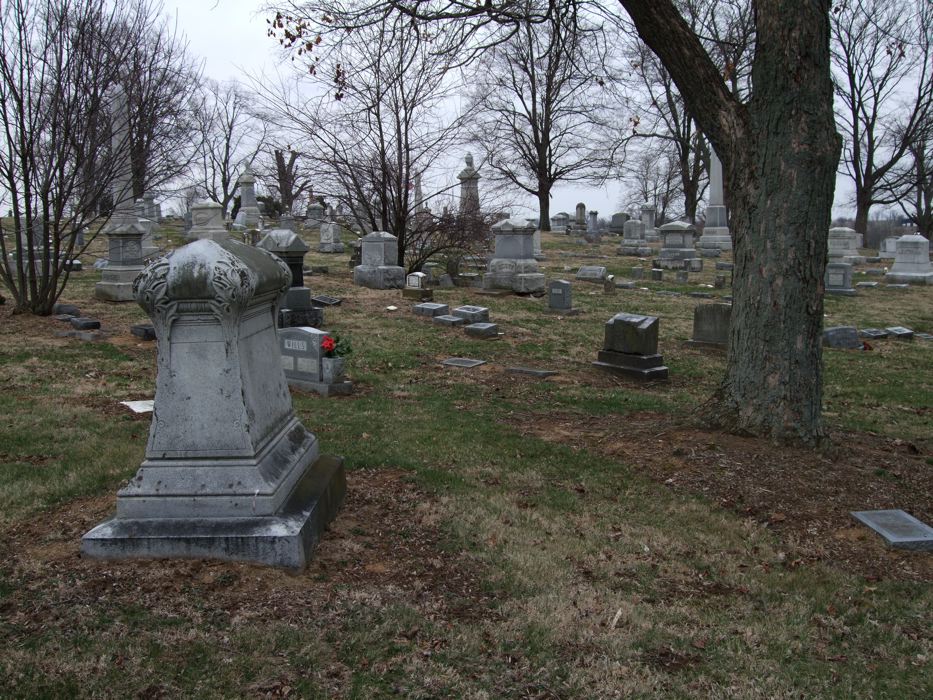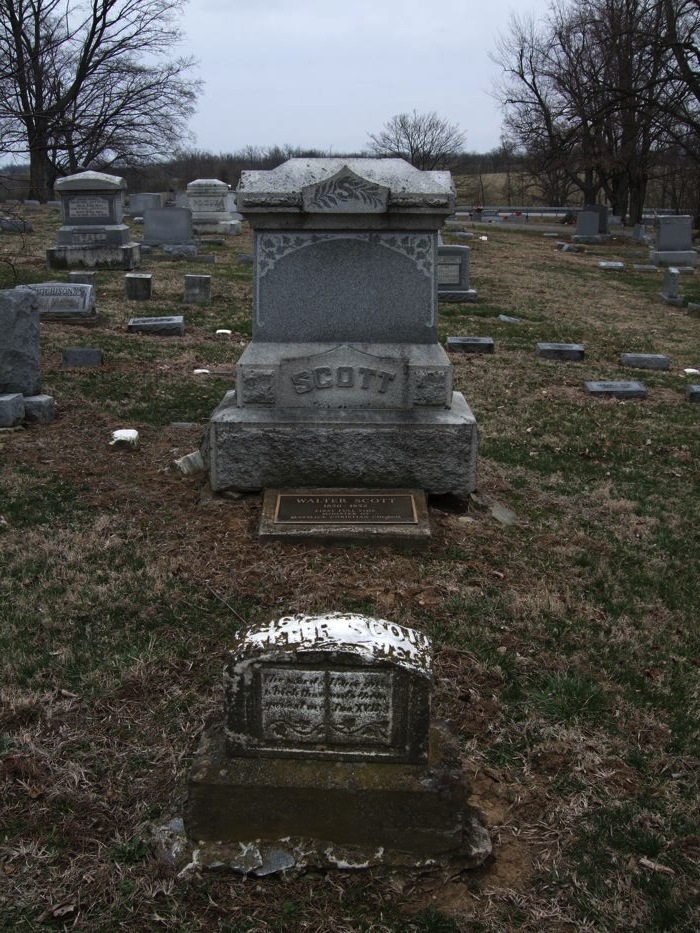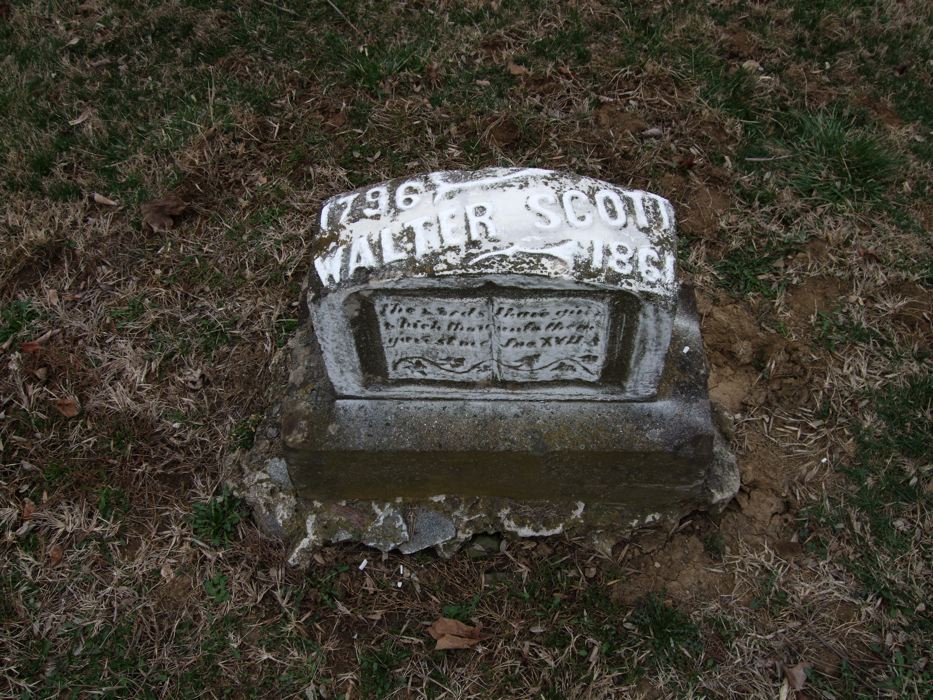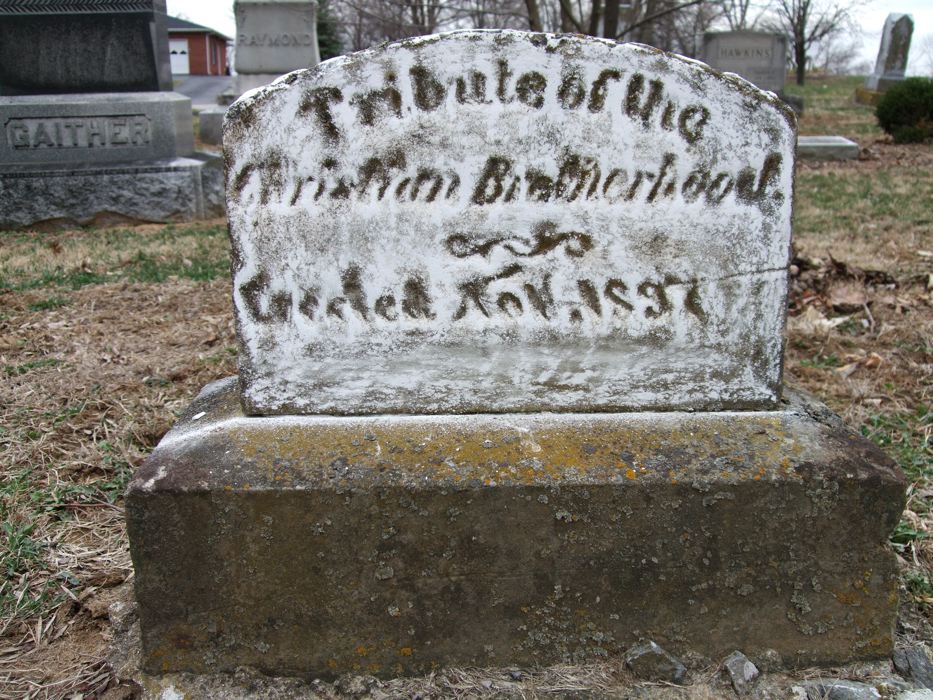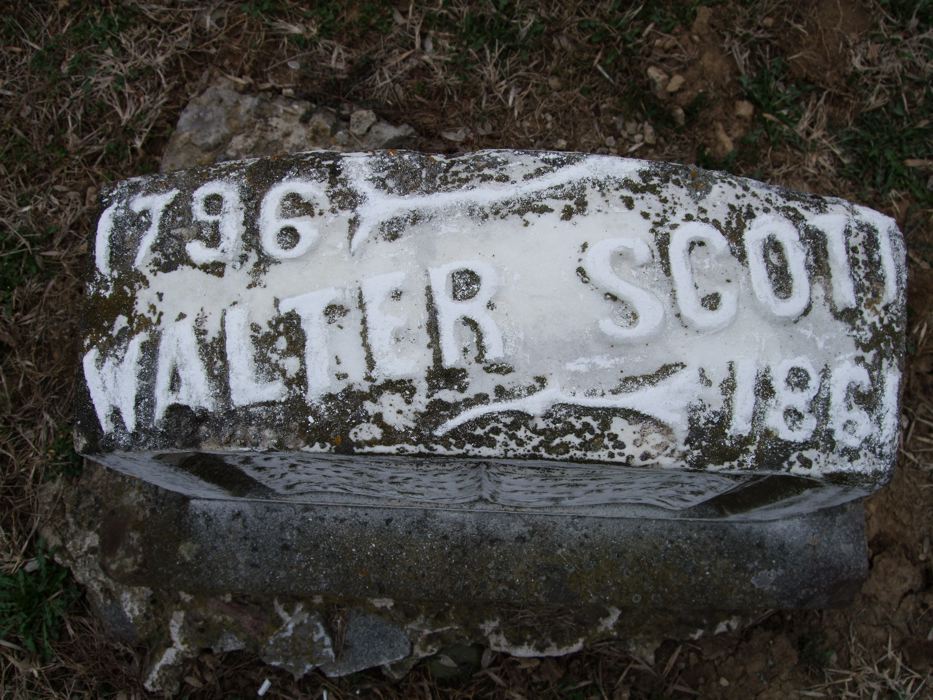Walter Scott
1796-1861
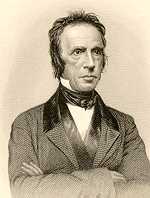
Biographical Sketch Of The Life Of Walter Scott
by Charles A. Young
One of the chief promoters of the great religious movement in modern times was Walter Scott. His ancestry as well as his name was the same as the renowned novelist of the last century. He was born on the last day of October, 1796, in Moffat, Scotland. His parents were John Scott and Mary Innes, who had five sons and five daughters. His father was a music teacher and a man of culture. The mother was refined and so sensitive that the news of her husband's death caused her death and she was buried in the same grave with him. Walter was the sixth of ten children. At the very beginning of this brief biographical sketch of one of the purest, noblest and truest spirits of the Restoration, we desire to let one of his pupils, who became the best historian of the Restoration, give us his estimate of Walter Scott. After telling us that Scott was a tutor for several years in his father's home, Dr. Richardson says: "It was about this period also that he wrote his Essays on Teaching Christianity, in the first volume of the Christian Baptist, in which he, over the signature of 'Philip,' first presented and developed the true basis and most important point in the Reformation, to-wit: The belief in Christ as the Son of God, the Christian faith and bond of Christian Union. Brother Scott really laid the true and distinctive foundation of the Reformation."
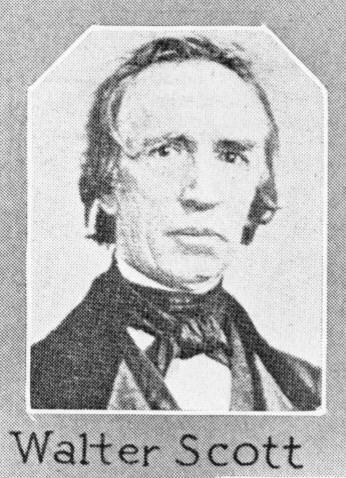
Baxter, in preparing his life of Walter Scott, found a dearth of material because this hero of the Cross had "lived so much for others that he had little thought or care for himself." We can only give a survey of the life of this great, gifted and God-fearing man. Before the death of his parents Walter was given good educational advantages. Through great economy he received training which usually only the children of wealthy parents enjoyed at the beginning of the Nineteenth Century. After the necessary academic preparation he entered the University of Edinburgh, where he completed the collegiate course. It was the prayer of his parents that he should "preach the Word." A touching incident of his boyhood days throws a flood of light upon the kindhearted character of this noble man. It is said that Martin Luther sang and begged for the lazy drones who belonged to a monastic order. Walter Scott when a boy of sixteen sang late at night for a poor blind beggar. Singing the sweetest of Scotch airs he poured out the fullness of a sympathetic heart in the interest of suffering humanity. Soon after he completed his University training, Walter Scott was influenced to come to America, by the fact that his uncle on his mother's side, George Innes, had a government position in New York City. He sailed from Greenock and reached New York July, 1818. His uncle was a man of integrity and highly esteemed. He secured Walter a position as Latin tutor in a classical academy on Long Island. Soon, however, he set out on foot with a light heart and a lighter purse, in company with a young man to go West. They reached Pittsburg in May, 1819, where Mr. Scott fortunately—we may say, Providentially, became acquainted with a fellow countryman, who had been greatly influenced by the Haldanes, Mr. George Forrester. He was the principal of the best academy in Pittsburg, and quick to recognize the superior talents and training of Walter Scott he engaged him as his head assistant. Mr. Scott soon found that Mr. Forrester held views which were then quite peculiar, though fortunately they are not so peculiar now. "Mr. Forrester's peculiarity consisted in making the Bible his only authority and guide in matters of religion, while his young friend had been brought up to regard the Presbyterian, Standards as true and authoritative exposition and summary of Bible truth." Being a diligent student of the Word of God, he soon saw the consistency of Mr. Forrester's position. The Bible had for him a new meaning. It was no longer a store-house of texts to confirm dogmatic systems, but a revelation, an unveiling of the will of God. "The gospel was a message and to believe and obey that message was to become a Christian." Seeing that religion was personal and not a matter of proxy, he made a careful study of the conditions of pardon, and being a thorough Greek scholar he was soon convinced that baptism should symbolize his death to sin and the rising to live a new life in Christ. He was baptized by Mr. Forrester who soon after gave up his academy and placed the management of it entirely in the hands of Mr. Scott. The school became very prosperous, but the principal felt that he ought to be preaching the glad tidings of salvation. "About this time a pamphlet fell into his hands, which had been put into circulation by a small congregation in the city of New York, and which had much to do with deciding the course he should pursue. The church alluded to was composed mainly of Scotch Baptists, and held many of the views held by the Haldanes, and were in many respects, far in advance of the other religious bodies. This pamphlet was published in 1820. It set forth with admirable clearness and simplicity the teaching of Scripture with regard to the design of baptism. The careful reader will find in it the germs of what was years afterwards insisted upon by Scott in his plea for baptism for the remission of sins and also by Alexander Campbell in his celebrated "Extra on Remission." We give a few extracts from this pamphlet:
ON BAPTISM
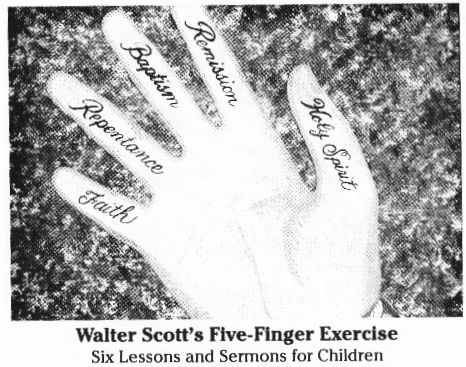
"It is not intended, in this article, to discuss the import of the term baptism, as that term is well known to mean, in the New Testament, when used literally, nothing else than immersion in water. But the intention is to ascertain what this immersion signifies, and what are the uses and purposes for which it was appointed. This can only be done by observing what is said concerning it in Holy Scripture. (Here follows an induction of quotations familiar to our readers. C. A. Y.) From these several passages (Mark 1:4, 5; John 3:5; Acts 2:38; Acts 22:16; Rom. 6:2-11; Gal. 3:26-28; Eph. 5:25, 27; Eph. 4:4, 6; Col. 2:12, 13; Titus 3:3, 6; 1 Peter 3:21), we may learn how baptism was viewed in the beginning by those who were qualified to understand its meaning best. No one who has been in the habit of considering it merely as an ordinance can read these passages with attention without being surprised at the wonderful powers, qualities, and effects, and uses, which are there apparently ascribed to it, if the language employed respecting it, in many of the passages, were taken literally, it would import, that remission of sins is to be obtained by baptism, and that an escape from the wrath to come is effected in baptism, that men are born the children of God by baptism; ** that men wash away their sins by baptism; that men become dead to sin and alive to God by baptism; that the church of God is sanctified and cleansed by baptism; that men are regenerated by baptism; and that the answer of a good conscience is obtained by baptism. All these things, if the passages were construed literally, would be ascribed to baptism. And it was a literal construction of these passages, which led professed Christianity in the early ages, to believe that baptism was necessary to salvation. Hence arose infant baptism, and other customs equally unauthorized. And from a like literal construction of the words of the Lord Jesus, at the last supper, arose the awful notion of transubstantiation.
"But, however such men may have erred in fixing a literal import upon these passages, still the very circumstance of their doing so, and the fact that the meaning they imputed is the literal meaning, all go to show that baptism was appointed for ends and purposes far more important than those who think of it only as an ordinance, yet have seen.
"It is for the churches of God, therefore, to consider well, whether it does not clearly and forcibly appear from what is said of baptism in the passages before us, taken each in its proper connection, that this baptism was appointed as an institution strikingly significant of several of the most important things relating to the Kingdom of God; whether it was not in baptism that men professed by deed, as they had already done by word, to have the remission of sins through the death of Jesus Christ, and to have a firm persuasion of being raised from the dead through Him, and after his example; whether it was not in baptism that they put off the ungodly character and its lusts, and put on the new life of righteousness in Christ; whether it was not in baptism that they professed to have their sins washed away, through the blood of the Lord and Savior; *** whether it was not in baptism that they passed, as it were, out of one state into another, out of the Kingdom of darkness into the Kingdom of God's Son; *** whether, in fact, baptism was not a prominent part of the Christian profession, or, in other words, that by which, the part, the Christian profession was made; and whether this one baptism was not essential to the keeping of the unity of the spirit."
This tract made a profound impression on the conscientious mind of Mr. Scott. He gave up his lucrative and delightful position and went to New York. But he was sadly disappointed. He found the practice of the church far below its high ideas. This same experience he had with regard to independent bands worshiping in Baltimore and Washington. In regard to his Washington City experience, he said: "I went thither and having searched them up I discovered them to be so sunken in the mire of Calvinism, that they refused to reform; and so finding no pleasure in them I left them. I then went to the Capitol, and climbing up to the top of its lofty dome, I sat myself down, filled with sorrow at the miserable dissolution of the Church of God."
After this Walter Scott returned to Pittsburg and resumed his teaching. He met the Campbells--Thomas and Alexander--wrote for the Christian Baptist, was married, and in 1826 moved to Steubenville, Ohio. In 1827 he accompanied Alexander Campbell to the Mahoning Baptist Association which met in New Lisbon, Ohio. Although he was only a "teaching brother," he was chosen at this meeting to be the evangelist for the Association. He had been preparing to publish a new paper to be called the Millennial Herald, but he gave up everything and entered with all the enthusiasm of his earnest nature into this new work. His first meeting, in which he preached the simple gospel, as in the days of the apostles, was at New Lisbon, Ohio, where only a few months before he had been appointed evangelist. This remarkable meeting resulted in a number of conversions. "His first step was to fix upon the divinity of Christ as the central and controlling thought of the New Testament, and which he afterwards demonstrated and illustrated with a strength and felicity that has never been surpassed. Next he arranged the elements of the gospel in the simple and natural order of Faith, Repentance, Baptism, Remission of Sins, and Gift of the Holy Spirit, then he made baptism the practical acceptance of the gospel on the part of the penitent believer, as well as the pledge or assurance of pardon on the part of its author." It was Walter Scott who at the last meeting of the Mahoning Association freed the disciples from the last vestige of human authority and placed them under Christ with His Word for their guide. In incessant labors with Adamson Bentley, John Henry, William Hayden and others he continued his work and gave the great evangelistic impulse to the Restoration Movement. The Messiahship of Jesus was the central theme of all his preaching. Next to Mr. Campbell, his co-laborer, Mr. Scott was one of the most prolific writers of the Restoration. He opposed the "Word alone" theory as well as the "Spirit alone" theory regarding conversion, and he was one of the first writers upon the Biblical view of the Holy Spirit. The latter part of his life was spent at Mayslick, Kentucky, where he died during the first year of the Civil War, April 23, 1861. He was a great preacher and did more than any other man to restore apostolic preaching. He was a learned man and his greatest work was the Messiahship or Great Demonstration, written for the Union of Christians on Christian principles.
- From Churches of Christ, by John T. Brown, c.1904, pages 408-410
![]()
Restoration Leaders: Walter Scott
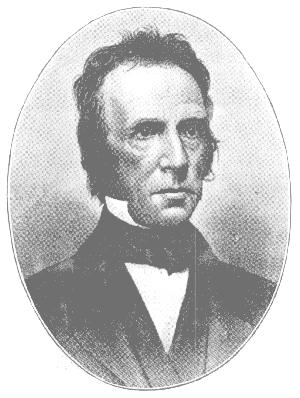
Walter Scott was born October 31, 1796 in Moffat, Dumfrieshire, Scotland to John Scott (a music teacher) and Mary Innes Scott and graduated from the University of Edinburgh in the class of 1817. Both parents died in 1821 within the same month. Brought up in the Presbyterian Church of Scotland, he was deeply religious, but found Calvinism unsatisfying and gave himself to searching out the ancient Gospel. At the invitation of his uncle, George Innes, he landed in America July 7, 1818 and became a teacher of Latin in a classical academy at Jamaica, Long Island, New York.
Catching the fever to "Go West", he and a companion walked from New York to Pittsburgh where he taught in a religious academy. George Forrester was principal and also a minister of a fundamental Baptist church. Forrester rejected all human creeds and accepted the Bible alone as his religious guide. This appealed to Scott and he sat at the feet of Forrester hour after hour examining the Scriptures. Having come to grips with immersion, as opposed to sprinkling or pouring, he was immersed by Forrester. While bathing in a river Forrester drowned and Scott became principal of the academy.
Walter Scott first met Alexander Campbell in the winter of 1821-22. After discussing their religious views they were surprised that they occupied similar ground; this meeting formalized the beginning of a cooperative movement in restoration preaching. In 1827 Alexander Campbell was instrumental in the selection of Scott as Evangelist for the Mahoning Association. His first sermon was in a Baptist church at New Lisbon, on the Western Reserve of Ohio- November 18, 1827. In the opening statement he quoted Acts 2:38; William Amend, who had just arrived at the meeting house, immediately made his way to the front and requested to be baptized "for the remission of sins". He had wrestled with the passage and had vowed that he would obey it the first time he heard it preached.
As a patriotic, country-loving citizen, Scott was crushed by the Civil War. For several months he refused to take the Lord's Supper because of strife among brethren. He was stricken seriously ill on April 16, 1861 (diagnosed as typhoid-pneumonia) and died April 23.
Women In His Life
He was first married to Sarah Whitsett at age 26. She inspired his ministry, overlooked his lack of money sense, endured his poverty, and of her he wrote at her death: "Best of wives, tenderest of mothers, the most faithful of friends, a Christian in faith, works and charity."
Next, he married Nattie B. Allen, beautiful, young and affectionate. When told she might outlive him she said: "I would rather be Walter Scott's widow than the wife of any other man." She died in 1854.
Finally, he married Eliza Sandidge. A rich widow who was intolerant and often drove him from the house. This was an unfortunate marriage.
Native Ability And Academia
J. J. Haley wrote concerning Walter Scott in Makers and Molders of the Reformation Movement: "Theology and the religious consciousness run in the blood north of the Tweed. Brains and reverence and appreciation of Biblical knowledge appear to be congenital with the typical Scotchman . . . His deep religious nature, his love of truth and righteousness, his keen perception, his fine capacity for the acquisition of knowledge, and his profound reverence for the Bible and the Christian religion, made him a splendid subject for instruction and inspiration to the Campbells" (page 60-61).
Walter Scott was a diligent Bible student and suggested that a chapter a day memorized will put the head of a family in possession of the entire New Testament in much less than a year. For Scott to have baptized 1000 each year of 1828 and 1829, he had to love the Bible and engage in some hard work.
Contribution To The Restoration Movement
As Mahoning Association Evangelist Several years earlier Scott had read a tract written by Henry Errett (father to Isaac Errett), an elder in a Haldanean "Church of Christ" in New York, on the subject of baptism for the remission of sins. This tract made a deep impression upon him, and when he became evangelist for the Mahoning Association he saw opportunity to put it into practice.
Faith, repentance, baptism, remission of sins, and the gift of the Holy Spirit-this was the "gospel restored" in Scott's preaching. The result was a great revival among Mahoning churches—but a different kind from those at Cane Ridge and other places in the West. There was none of the emotionalism, no exercises, no continuous camp meetings. Hundreds responded. His work on the Western Reserve mushroomed, but not without opposition. One young man threatened to shoot him if he baptized his mother. Sects were aroused, names were called, challenges were issued. Scott was in demand everywhere—New Lisbon, Deerfield, Austintown, Warren, and scores of other places. Within two years people were stirred up like never before.
Alexander Campbell heard of the revival sweeping the Mahoning churches and sent his father to observe. After seeing, Thomas Campbell wrote that even though they had understood the gospel correctly for a number of years, it was now being put into practice for the first time. As a result of the revivals the total membership of the Mahoning churches was more than doubled within one year. By 1830 the Association had been so transformed that it dissolved itself out of existence.
As Publisher and Author
Walter Scott began publishing a paper, "The Evangelist", in 1832. This work was given to Restoration principles. It was discontinued in 1835 in favor of doing research for his great book, "The Gospel Restored", which was published in 1836. "The Evangelist" was resumed in 1836. Among his other writings were: a pamphlet on "The Holy Spirit," and a "Disciple's Hymnal." His writing was crisp and direct in style, flavored with beauty of language and clearness of thought. His one passion in writing was his burning desire to present the Gospel restored.
His purpose for writing "The Gospel Restored" is stated in the preface: "The professors of our holy religion having unhappily strayed from the scriptures and true Christianity, there seemed to be no remedy in anything but a return to original ground. This suggested itself to many, in different places, almost simultaneously, about the beginning of the present century, and numerous churches were formed about that time, both in Europe and America, resembling, more or less, the churches planted by the Apostles, or the church of Jerusalem instituted by the Lord Jesus himself. These churches, with few exceptions, adopted the holy scriptures as their exclusive guide in religion, and rejected the dangerous creeds and confessions of Christendom, which have operated so fatally on the unity of the churches. This formed the first positive step toward that return to original ground, for which the present century is distinguished."
A systematic view of Christianity beginning with the original fallen state of man, "The Gospel Restored" is one of the most comprehensive and convincing works of the Restoration Movement. Moses Lard told Scott that it was this book that first taught him the Gospel.
As "The Golden Oracle"
Historians of the Restoration Movement give Walter Scott first place in oratorical expertise. They all seem to be quoting from the same source-although their writings are not always documented:
M. M. Davis, in The Restoration Movement of the Nineteenth Century, wrote: "His warm heart, his musical voice, his chaste and charming language, his tender pathos, his winsome personality, his burning zeal and his great theme—the MESSIAHSHIP—made him almost irresistible" (page 164).
Dabney Phillips, in Restoration Principles and Personalities, wrote: "With his analytical mind, Scott was able to simplify a subject that all might understand. He told the people that the gospel was threefold—facts, commands, and promises. The facts were to be believed, the commands were to be obeyed, and the promises were to be enjoyed. He applied the gospel by emphasizing: (1) faith to change the heart, (2) repentance to change the life, (3) baptism to change the state, (4) remission of sins to cleanse from guilt, and (5) the gift of the Holy Spirit to help in the religious life and to make one a partaker of the divine nature . . . He once preached on 'Three Divine Missions'—one hour on the mission of Christ, one hour on the mission of the Holy Spirit, and one hour on the mission of the Church. He was able to hold his audience spell-bound for three hours" (pages 136-137).
J. J . Haley, in Makers and Molders of the Reformation Movement, wrote: "The big four of the current reformation are Thomas Campbell, Alexander Campbell, Barton W. Stone and Walter Scott. The last named is fourth in enumeration, but by no means fourth in distinctive importance.
In originality of conception, vigor of presentation, enthusiasm, courage, boldness and eloquence, he comes near heading the list. He was not the initiator of any original movement within the church like his three illustrious comrades, but so far as the distinctiveness of his contributions to the new movement was concerned, he stands first in historical and theological importance.
"This masterful proclaimer of the Word combined the didactic, the poetic, and the evangelistic to a degree astonishingly unusual. His mind was as straight and clear in the comprehension and explanation of facts as his emotional nature was strong and moving in his appeals to men to be reconciled to God. His powers of analysis and classification were phenomenal" (pages 59-63).
Isaac Errett once said in referring to a great sermon preached by Dr. Armitage of New York, "I have not heard such preaching since Walter Scott."
An attorney in Kentucky said: "At his worst he could beat them all, and at his best he could beat himself."
CONCLUSION
Those who molded Walter Scott were his parents; his music teacher; John Scott; George Forrester whose congregation rejected infant baptism, accepted only the Scriptures as authority, and practiced weekly communion; and Alexander Campbell who became his companion on the lonely Reformation road.
Alexander Campbell provided the intellectual direction, while Walter Scott provided the evangelistic fervor for the Restoration Movement. Robert Richardson, Campbell's biographer, wrote: "Among the helpers and fellow laborers of Alexander Campbell, the first place must be awarded to Walter Scott. Walter made the apostles his model, and went before the world with the same message, in the same order, with the same conditions and promises."
The highest tribute to be paid to his life is found engraved in the headstone of his grave at Mays Lick, Kentucky. "The words which thou gavest me, I have given unto them" (John 17:8). — John P. Simpson, 1981 Freed-Hardeman University Lectures, pages 324-328
![]()
Life Of Walter Scott
1796
October 31
Born in Moffatt, Dumfrieshire, Scotland, 4th son and 6th child of John and Mary Innes Scott
1810
At 14, entered College of Arts in Edinburgh
1817
Graduated from University Of Edinburgh
1818
July 7
26 years old—Arrived at New York-came at suggestion of uncle, George Innes
1819
May 7
Arrived at Pittsburg, PA. Taught in school operated by George Forrester. Forrester preached for "Haldane" church. Scott immersed
1820
Spring
Forrester withdraws from school, leaving Scott responsible for school, then drowns in Allegheny River, leaving Scott responsible for the church as well.
1821
June 7-8
Both of his parents: John dies suddenly and within one day Mary Innes Scott dies.
1821
Spring
Read tract "On Baptism" by Henry Errette, father of Isaac. Went to New York to visit church. Disappointed. Returned to Pittsburgh to tutor Robert Richardson and a few others boys.
1821-22
Winter
First met Alexander Campbell at Richardson home during winter: Campbell is 33, Scott is 25
1823
January 3
Married Sarah Whitsett (Stevenson wrote that the marriage took place on the 30th of Jan. according to autobiographical info, Voice of the Golden Oracle, p.41; but Baxter says it was the 3rd, Life of Elder Walter Scott on page 72)
1823
Spring
Suggested title Christian Baptist to A. Campbell, as prospectus of the new magazine was distributed
1823
August
Contributed articles to CB, appeared under signature of “Philip”
1823
October
Suggested the teaching of baptism “for remission of sins” to A. Campbell in preparation for debate with Wm. L McCalla, Richardson, Memoirs of A.C., Vol.2, p.8
1823
November 19
1st child born, John Passmore Scott (1823-1879)
1824
Scott’s congregation merged with Baptist church in Pittsburg with Sidney Rigdon’s congregation
1825
Took control of Pittsburgh church when Rigdon departed for Ohio
1825
September 24
2nd child born Emily Harden Scott (1825-1910)
1826
Late Spring,
Early Summer
Moved to Steubenville, Ohio. Opened an Academy
1826
Aug. 25-27
Attended meeting of Mahoning Association with Campbells at Canfield, Ohio. Invited to preach on Sunday morning – on Matthew 11
1826
December 6
3rd Child – son William Adolphus is born (1826-1897)
1827
Spring
Released prospectus for new journal, Millennial Herald, reported in June 4 ed. Of Christian Baptist
1827
August 23-25
Attended Mahoning Assoc. meeting at New Lisbon. Employed as evangelist to Western Reserve. (1827-1830) Only 34 baptisms reported in previous year, but under Scott 1000 the next. (VOTGO, p.55; LOEWS, p.83ff)
1827
September 16
Braceville, Ohio—Jacob Osborne, Adamson Bentley and W.S. crystalize in their minds the essentiality of baptism for remission of sins. And, with it, the essentials of the current reformation: 1. The plea for the Bible as the only rule of faith and practice (rejecting credalism); 2. Apostolic order is essential (interpretation); 3. The fullness of the True gospel restored. (faith, repentance, baptism for remission of sins, forgiveness, gift of the Holy Spirit, eternal life. (VOTGO, p.63-64)
1827
November 18
Baptized Mr. Amend—first man among Disciples’ movement to be baptized for the remission of sins. (Stone’s Christian movement preceded this by one year)
1827
Fall
Moves Stubbenville to Canfield, Mahoning County, Ohio
1828
December 2
With Adamson Bentley at Braceville Ridge schoolhouse, Ohio
1828
March
Met Sidney Rigdon, brother-in-law of A. Bentley at Warren. Greatly influence Rigdon in teaching on baptism for remission of sins
1828
August 29
Reported at the Mahoning meeting in Warren, Ohio, report of more than 1000 people since Aug. ’27. He also defended appointment of Aylette Rains to the ministry if he could keep his “Universalism” views to himself. Also said, “Give me my Bible, my head and Brother William Hayden, and we will go forth to convert the world." (VOTGO, p.98)
1828
December 31
2nd daughter and 4th child Sarah Jane born at Canfield, OH (1828-1831) W.S. entered a period of deep depression.
1829
William S. Hayden (song-leading and preaching) traveled with Scott in Western Reserve
1829
At Shalersville, Ohio, Dr. Robert Richardson came to Scott to be baptized
1830
August
Mahoning Assoc. annual meeting at Austintown, OH. Over 1000 baptized on
Western Reserve the year previous.
1830
Census reported Walter Scott family living in Trumbull County, Ohio
1830
December 20
3rd son, 5th child born – Samuel Church Scott (1831-1888)
1831
Wrote “Discourse on the Holy Spirit”Memoirs A.C. v.2p.356
1831
Early Winter Moved to Pittsburg. Exhausted after hectic years as Mahoning evangelist.
1831
Sarah Jane, his 2nd daughter dies, 2 yrs old. Scott is plunged into depression and melancholy. Continued for months.
1831
May
To Cincinnati. Sermons disappointing. Return to Pittsburg.
1831
October
Wrote A Discourse on theHoly Spiritpublished by A.C. Depression lifts.
1831
December
Moved to Cincinnati and revived plans for journal, the Evangelist
1832
January 2
Evangelist: 1st issue, 24 sheets, monthly.
1832
Summer
Evangelized and planted church in Carthage (7 mi. n. of Cincinnati) –
worked during week in Cin. & Sundays in Carthage
1833
March 10
Walter Harden Scott born (1836-1922) (Some sources say he was born in 1836)
1833
October
Moved to Carthage (Stays 13 years) to preach for church and edit Evangelist. – Health is poor.
1833
December 31
Evangelistic trip to Virginia
1834
Had regained health and energy
1835
March 9
Evangelistic Trip to Kentucky, L.H. Jameson, his student, travels with him
1835
August
Production of 1st hymnal of united RM churches bearing the authors names of Barton W. Stone, Alexander Campbell, Walter Scott & John T. Johnson. Controversial!
1836
Early Months
Discontinued Evangelist for one year to concentrate energies on book—wrote The Gospel Restored (576 pp.).
1836
November 10
First president of Bacon College. Served one year.
1837
February
Delivers 1st Inaugural Address of Bacon College
1837
Fall
Addressed The College of Teachers and Western Literary Society in Cincinnati, OH. Prominent and world-renowned authors in attendance
1837
During the year
Co-edited The Christian with John T. Johnson – in place of Evangelist.
1837
Oct. 20 - Dec. 20
Trip to Pittsburgh & Western Reserve churches
1838
January
Evangelist resumed: New Title: The Evangelist Of The True Gospel
1838
December
Produced a new hymnal for Disciples churches
1839
October
Family moved back to Cincinnati to better educate children
1841
January
Moved back to Carthage
1841
Carthage Editorial controversy with Alexander Campbell caused alienation. Issue: had Scott "restored the gospel" in 1827? Controversy flared occasionally through 1841
1841-42
Winter
3 month tour of northeast: Baltimore, Philadelphia and NY
1844
Evangelist discontinued. Returned to live in Pittsburg. Rift with Campbell healed. New journal with Robert Forrester called Protestant Unionist.
1845
April 10
Editorial offices of Protestant Unionist ravaged by fire in the disastrous fire of 1845.
1846
Preached at Kentucky State meeting in Georgetown.
1848
December 1
Wrote in his diary: “The first day of my eldership. Studied, wrote, and walked to the top of the hill north."
1849
April 28
Wife, Sarah died. Moved to Cincinnati. Christian Age and Unionist. Attended convention that organized missionary society.
1849
November 17
Held meeting at Mayslick, Kentucky – 13 Day Mtng.
1849
November 29
Hired by Mayslick, Mason County, Kentucky church
1850
August 13
U.S. Federal Census places W.S. living in a boarding house in Mason County, Kentucky also some in the home of his son Samuel Church Scott
1850
August 13
Moved to Mays Lick, Ky. Married Annie B. Allen (Stevenson said she was “Nannie.” Baxter calls her Annie, p.421.)
1852
March 7th
child born – Carrie Allen Scott (1852-1915)
1852
April 11
To Covington, Ky. Writes The Union of Christians on Christian Principles. 128 pp.
1853
Writes companion volume, The Death Of Christ, 132 pp.
1854
November 18
Annie (Nannie) dies – Leaving one daughter, Carrie Allen Scott
1855
August 30
Returned to Mays Lick. Married a widow, Eliza Ann Riddle Sandidge. Unhappy marriage. Continued evangelistic work. (1855-1884)
1859
April
Writes The Messiahship or Great Demonstration (394 pp.).
1860
Disconsolate at prospect of war. Wrote essay "Crisis."
1861
April 16
Took ill with Typhoid Pneumonia
1861
April 23
Died at Mays Lick. Campbell wrote, "Next to my father, he was my most cordial and indefatigable fellow laborer . . . I knew him well. I knew him long. I loved him much."
LOEWS - William Baxter, Life of Elder Walter Scott (Cincinnati, 1874);
VOTGO - Dwight Stevenson Walter Scott: Voice of the Golden Oracle (St. Louis, 1946).
—Sources: The initial work on this chronology was produced by Bill Humble. Additions were gleaned from other works and added here by your web editor.
![]()
Directions To The Grave of Walter Scott
From Lexington, Kentucky go north on Hwy 68 toward Washington. You will pass through Paris, Carlisle, and other little communities. As you approach Mayslick, turn left on SR2517. This will take you toward the township of Mayslick. Very quickly you will notice the graveyard on the right. Pull into the first little grave road on the right and stop the car almost immediately. Get out of the car and go into the grave section to your left. Scott's grave is a few markers in, very near and facing SR2517. While parked there be sure to walk across the street and see the home of Walter Scott. Click Here! to see photos of his home and the Mayslick church where he preached, which is located further into town on the left. I've been there a couple of times. In May of 2001, I was with Wayne Kilpatrick, and others on a trip. We found someone to allow us to go into the building and look around. It is well worth the trip to Mayslick, Kentucky.
GPS Location
38°30'48.1"N 83°50'38.1"W
or D.d. 38.513356,-83.843925
![]()
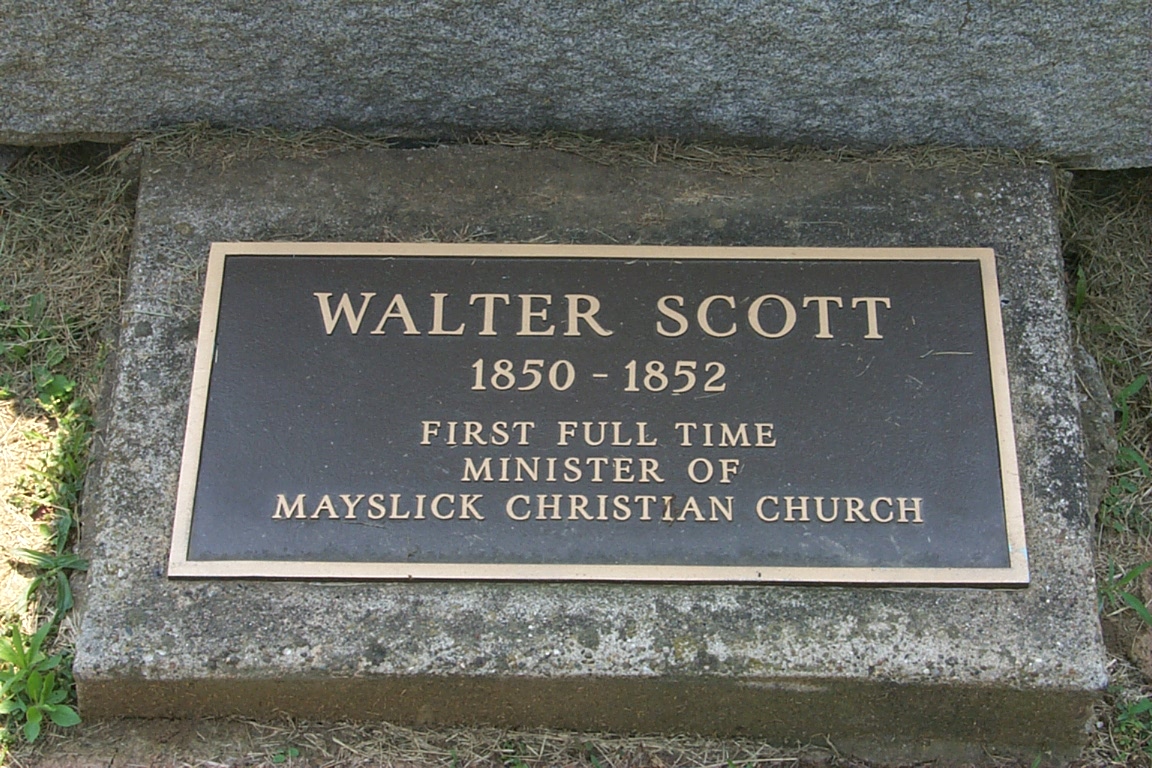
Walter Scott
1850-1852
"First Full Time
Minister of
Mayslick Christian Church
More Photos Of Walter Scott & Mayslick, Kentucky
![]()
